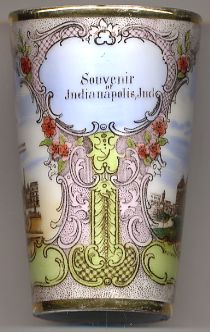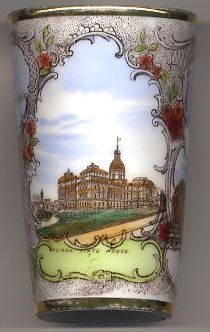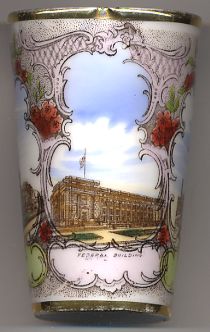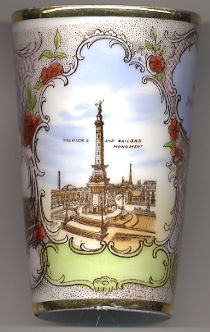

|
| UNITED STATES OF AMERICA | |
| INDIANA | |
| Marion County |

|
Indianapolis, abbreviated Indy, is the capital of the U.S. state of Indiana, and the county seat of Marion County, IN.
As of the 2010 United States Census, the city's population is 829,718. It is thus Indiana's largest city and the 12th largest city in the U.S.,
the second largest city in the Midwest (behind Chicago), the second most populous state capital (after Phoenix, AZ),
and the most populous state capital east of the Mississippi River.
Native Americans who lived in the area originally included the Miami and Lenape (or Delaware) tribes, but they were displaced from the area by the early 1820s.
Indianapolis was selected as the site of the new state capital in 1820, the old state capital having been Corydon since the formation of the state of Indiana.
It was founded on the White River both because of the fact that the place is close to the exact geographical centre of the state, and because of the incorrect
assumption that the river would serve as a major transportation artery. However, the waterway eventually proved to be too sandy for trade.
The state commissioned Alexander Ralston to design the new capital city. Ralston was an apprentice to the French architect Pierre L'Enfant, and he helped
L'Enfant plan
The  Indiana Statehouse is the state capitol building of the U.S. state of Indiana. Housing the Indiana General Assembly,
the office of the Governor of Indiana, the Supreme Court of Indiana, and other state officials, it is located in the state capital Indianapolis at
200 West Washington Street. Built during 1888, it is the fifth building to house the state government.
The first statehouse, located in Corydon, Indiana, is still standing and is maintained as a state historic site.
The second building was the old Marion County courthouse which was demolished and replaced during the early 20th century.
The third building was a structure modeled on the Parthenon, but was condemned during 1877 because of structural defects and razed so the current statehouse
could be built on its location.
When the third statehouse was condemned during 1876 the government abandoned the building. The General Assembly relocated to a large office building that had
been built during 1865 that was already housing the Supreme Court. The Governor and the executive staff relocated to another office building.
The state office building was used as the statehouse during the interim period that the new statehouse was being built.
The structure of the current, 5th, statehouse was designed by Edwin May, an Indianapolis architect.
Construction began during 1880 and the cornerstone was laid on September 28. Edwin May died during February of that year, and Adolph Sherrer supervised the
project for the entire construction period. The interior was modeled in the Italian Renaissance style. Wherever possible, materials native to Indiana were used.
Doors were made of Indiana oak, and Indiana limestone was used throughout the structure.
The central dome was completed during 1883. The building was also wired for electricity, even though Indianapolis did not yet have an electrical power grid.
During 1887, the new capitol was sufficiently finished for the first legislative session to be held there. Construction ultimately endured eight years, and the
building was completed finally during October 1888.
With the pinnacle of the building reaching 256 ft (78 m) high, it was the second tallest building in the state at the time of its completion.
During 1988, the administration of Governor Robert D. Orr proposed that the Indiana General Assembly renovate the statehouse as part of "Hoosier Celebration '88",
the building's one-hundredth anniversary. The General Assembly approved, and the building had an extensive, $11 million dollar renovation that continued until 1995.
During 1984 the statehouse was added to the National Register of Historic Places, and it remains a protected building. Indiana Statehouse is the state capitol building of the U.S. state of Indiana. Housing the Indiana General Assembly,
the office of the Governor of Indiana, the Supreme Court of Indiana, and other state officials, it is located in the state capital Indianapolis at
200 West Washington Street. Built during 1888, it is the fifth building to house the state government.
The first statehouse, located in Corydon, Indiana, is still standing and is maintained as a state historic site.
The second building was the old Marion County courthouse which was demolished and replaced during the early 20th century.
The third building was a structure modeled on the Parthenon, but was condemned during 1877 because of structural defects and razed so the current statehouse
could be built on its location.
When the third statehouse was condemned during 1876 the government abandoned the building. The General Assembly relocated to a large office building that had
been built during 1865 that was already housing the Supreme Court. The Governor and the executive staff relocated to another office building.
The state office building was used as the statehouse during the interim period that the new statehouse was being built.
The structure of the current, 5th, statehouse was designed by Edwin May, an Indianapolis architect.
Construction began during 1880 and the cornerstone was laid on September 28. Edwin May died during February of that year, and Adolph Sherrer supervised the
project for the entire construction period. The interior was modeled in the Italian Renaissance style. Wherever possible, materials native to Indiana were used.
Doors were made of Indiana oak, and Indiana limestone was used throughout the structure.
The central dome was completed during 1883. The building was also wired for electricity, even though Indianapolis did not yet have an electrical power grid.
During 1887, the new capitol was sufficiently finished for the first legislative session to be held there. Construction ultimately endured eight years, and the
building was completed finally during October 1888.
With the pinnacle of the building reaching 256 ft (78 m) high, it was the second tallest building in the state at the time of its completion.
During 1988, the administration of Governor Robert D. Orr proposed that the Indiana General Assembly renovate the statehouse as part of "Hoosier Celebration '88",
the building's one-hundredth anniversary. The General Assembly approved, and the building had an extensive, $11 million dollar renovation that continued until 1995.
During 1984 the statehouse was added to the National Register of Historic Places, and it remains a protected building.
http://en.wikipedia.org/wiki/Indiana_Statehouse]
[Other Capitol buildings depicted on items of this collection are the United States Capitol in
Washington, DC, the Massachusetts State Capitol and the Old State House in
Boston, MA, the Colorado State Capitol Building in Denver, CO,
and the New York State Capitol in Albany, NY.]


The  Birch Bayh Federal Building and U.S. Courthouse (formerly known as the U.S. Courthouse and Post Office)
is a distinguished example of Beaux Arts architecture. It was one of only 35 federal buildings constructed under the Tarsney Act of 1893.
The Treasury Department sought designs for the new federal building from private architectural firms through an open competition allowed under the Act.
John Hall Rankin and Thomas Kellogg, noted Philadelphia architects, secured the design contract, and the Treasury Department
accepted the New York-based John Pierce Company's low construction bid of $1,300,000. (The final cost, however, reached nearly $2,000,000.)
Begun in 1902 and completed in 1905, the new federal building was massive. Accommodating 925 federal employees, the U-shaped, Beaux Arts structure occupied
an entire block, rose four stories, and housed federal courts, offices, and the main post office.
Beaux Arts classicism, often reflected in federal buildings of this era, was popularized by the majestic buildings of the Chicago
World's Fair in 1893. Completed in 1905, the new federal building was originally U-shaped. The symmetrical façade features evenly spaced Ionic pilasters
and terraces with stone balusters. A heavy classical cornice tops the building. A five-story addition, completed in 1938, enclosed the original U-shaped plan,
creating an interior courtyard. The original impressive scale and richly ornamented interior design elements remain intact. Mosaic tile ceilings, cantilevered
marble staircases, and much of the original decorative artwork and furnishings are still in place. Among the most impressive interior features of the building
are the Depression-era murals. Working under the Treasury Relief Art Project, which aimed to restore faith in the country through patriotic and historically
themed art, master artist Grant Christian painted murals that depict the history of transportation and delivery of mail in Indianapolis.
In recent years, GSA (General Services Administration) has reversed some past modifications made in the name of modernization, and has begun conserving important
elements of the building. GSA has replaced modern lighting with appropriate period features, repaired mosaic tile ceilings, and restored exterior stone work.
In 1974, the Federal Building and U.S. Courthouse was listed in the National Register of Historic Places. Birch Bayh Federal Building and U.S. Courthouse (formerly known as the U.S. Courthouse and Post Office)
is a distinguished example of Beaux Arts architecture. It was one of only 35 federal buildings constructed under the Tarsney Act of 1893.
The Treasury Department sought designs for the new federal building from private architectural firms through an open competition allowed under the Act.
John Hall Rankin and Thomas Kellogg, noted Philadelphia architects, secured the design contract, and the Treasury Department
accepted the New York-based John Pierce Company's low construction bid of $1,300,000. (The final cost, however, reached nearly $2,000,000.)
Begun in 1902 and completed in 1905, the new federal building was massive. Accommodating 925 federal employees, the U-shaped, Beaux Arts structure occupied
an entire block, rose four stories, and housed federal courts, offices, and the main post office.
Beaux Arts classicism, often reflected in federal buildings of this era, was popularized by the majestic buildings of the Chicago
World's Fair in 1893. Completed in 1905, the new federal building was originally U-shaped. The symmetrical façade features evenly spaced Ionic pilasters
and terraces with stone balusters. A heavy classical cornice tops the building. A five-story addition, completed in 1938, enclosed the original U-shaped plan,
creating an interior courtyard. The original impressive scale and richly ornamented interior design elements remain intact. Mosaic tile ceilings, cantilevered
marble staircases, and much of the original decorative artwork and furnishings are still in place. Among the most impressive interior features of the building
are the Depression-era murals. Working under the Treasury Relief Art Project, which aimed to restore faith in the country through patriotic and historically
themed art, master artist Grant Christian painted murals that depict the history of transportation and delivery of mail in Indianapolis.
In recent years, GSA (General Services Administration) has reversed some past modifications made in the name of modernization, and has begun conserving important
elements of the building. GSA has replaced modern lighting with appropriate period features, repaired mosaic tile ceilings, and restored exterior stone work.
In 1974, the Federal Building and U.S. Courthouse was listed in the National Register of Historic Places.
[http://www.gsa.gov/portal/ext/html/site/hb/category/25431/actionParameter/exploreByBuilding/buildingId/502]
The  Soldiers' and Sailors' Monument is a 284 ft 6 in (86.72 m) tall neoclassical monument in the center of Indianapolis
that was designed by German architect Bruno Schmitz and completed in 1901. The monument was erected to honor Hoosiers who were veterans of the American Revolution,
territorial conflicts that partially led up to the War of 1812, the Mexican-American War, the US Civil War, and the Spanish American War. In addition to its external
commemorative statuary and fountains (made primarily of oolitic limestone and bronze) the basement of the monument is the Colonel Eli Lilly Civil War Museum,
a museum of Indiana history during the American Civil War. At the top there is also an observation deck that can be reached by stairs for free or by elevator.
It takes 331 steps to reach this deck, 330 of which are numbered. Soldiers' and Sailors' Monument is a 284 ft 6 in (86.72 m) tall neoclassical monument in the center of Indianapolis
that was designed by German architect Bruno Schmitz and completed in 1901. The monument was erected to honor Hoosiers who were veterans of the American Revolution,
territorial conflicts that partially led up to the War of 1812, the Mexican-American War, the US Civil War, and the Spanish American War. In addition to its external
commemorative statuary and fountains (made primarily of oolitic limestone and bronze) the basement of the monument is the Colonel Eli Lilly Civil War Museum,
a museum of Indiana history during the American Civil War. At the top there is also an observation deck that can be reached by stairs for free or by elevator.
It takes 331 steps to reach this deck, 330 of which are numbered.
Further well-known monuments designed by Bruno Schmitz are the Völkerschlachtdenkmal (People's Battle Monument) in Leipzig (1898–1913),
The Kyffhäuser Monument on the summit of the Kyffhäuser Mountain (1892–1896), the Kaiser Wilhelm Monument at
Porta Westfalica (1892–1896), and the Deutsches Eck (1894–1897, also a monument for Emperor Wilhelm I) at
Koblenz, Germany.

| |||||||
![[scale]](lineal.jpg)